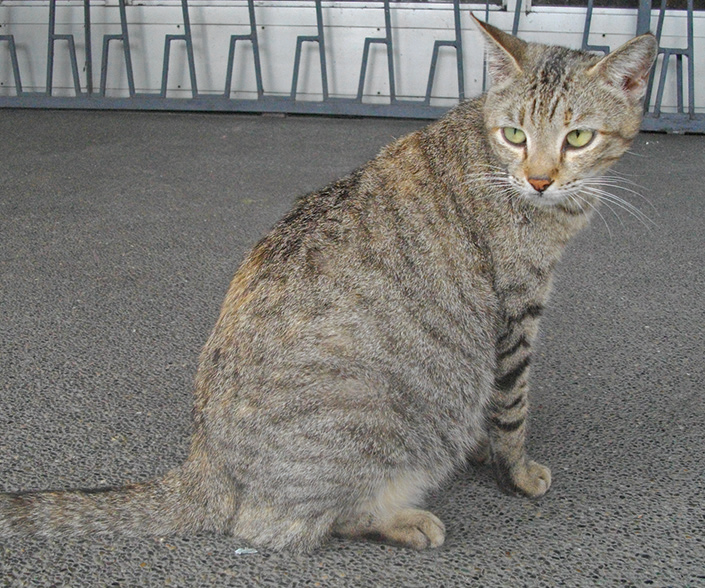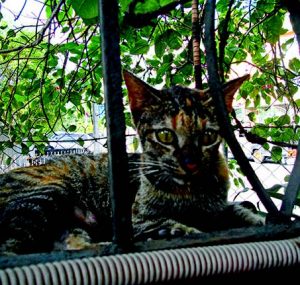On an ordinary school day, a fat female orange cat sits on a white plastic bench outside a classroom at the second floor of Plaridel Hall. She waits for the classroom door to open and students to file out of the class. The cat perks up as two girls and a boy head straight for her, pat her head and stroke her back. She closes her eyes and blissfully takes in the love and attention heaped on her. When the boy sits beside her, she quickly clambers onto his lap.
We call her “Twixie” but the students have named her “Ginger.”
Twix is one of the 30 cats at the College of Mass Communication (CMC) in UP Diliman. Most of them have been neutered and so, for a while, we couldn’t understand why the cat population was growing. But I recently found out that some students rescue kittens and bring them to a place they consider to be safe: the CMC.

At the School of Urban Planning (SURP), another orange cat, male this time, hangs out all day at the lobby. He is known as the school’s official receptionist since he meets and greets people at the entrance. Students, staff, and faculty drop by to say hello to him, and sit on the sofa to stroke him. They call him “Tisoy,” and he, together with a female cat and two gentle dogs cared for by staff and faculty, are very much considered part of the SURP community.
When the university’s dog catcher came to round up the cats and dogs early this year, faculty and staff refused to hand over the animals.
At the College of Science, some professors even bring their dogs to their lecture and laboratory classes. Apparently, the dogs entertain the students and relieve them of classroom stress.
Cats at the College of Fine Arts are allowed to sit in during class. Art professors probably understand just how soothing and inspiring the feline presence can be for aspiring artists.
All over the campus of UP Diliman, you can come across scenes like these as humans, cats and dogs reach across the interspecies divide and seek each other’s company.
But not all of UP Diliman was—and is—friendly to animals.
Cases of Cruelty
In 2005, a CMC official ordered security guards to kill a dog that had bitten his mother’s newborn pups. The dog was a fixture in the college—fed, raised, and cared for by staff and students. I often watched him sleeping at the feet of students. He had never harmed anyone, except his siblings after a fight with his mom.
According to the Animal Welfare Law, only a veterinarian could have decided whether the dog was dangerous or not to people.
Years later, another top CMC official allegedly ordered four cats dumped in Bulacan. The wife of the canteen concessionaire at the time told me they were ordered to remove the cats from the premises and dump them far away where they couldn’t find their way back.
In the Area 2 residential area, a UP employee used to shoot stray cats with a pellet gun and male employees at the former grocery used to stomp on unwanted kittens. The witness was too afraid to stop them because she feared she would be fired.
In 2011, a student from the National Institute of Physics found himself the object of an online hate campaign and negative news coverage when he blogged about how he had enjoyed killing a kitten. Because of his age, instead of imprisonment, the judge made him clean the cat enclosures at the PAWS shelter for several days.
Then in 2012, students from Albert Hall desperately sought help to rescue 9 cats who were about to be rounded up by the barangay. They didn’t want the cats to be killed at the pound so they adopted them. Later, one of the students asked me not to write about the rescue because they had been reprimanded and they were afraid any publicity might affect their grades.
In July 2015, at a canteen near the College of Law, 9 cats and kittens were shoved into a sack to be dumped in a place far away. Concerned employees sent an urgent text to CARA president Nancy Cu Unjieng, who asked me to check it out. All the cats were rescued and placed in a safe home.
The list goes on.
Hope for the Animals
But the good news is that there are efforts underway to save the animals of UP Diliman. In July 2015, Chancellor Michael Tan, who is a veterinarian and an animal welfare supporter, stopped the roundup of animals in the different units and colleges.
The roundups were ineffective—not long after the cats were taken from the colleges and brought to the Quezon City pound to be killed, another group of cats would fill in the vacuum and take up residence in the vacated space.
Although there is no official policy on the management of stray cats and dogs in the campus, various individuals and groups are trying to turn UP into an animal-friendly place.
After all, the dogs and cats are part of the UP community, as Vice-Chancellor for Community Affairs Nestor Castro told a crowd gathered at the Sunken Garden in October 2015 for the first dog picnic ever held on campus.

The animals have roles to play, too. Dogs beef up security in the units and keep the employees and security guards company in the lonely late hours. There are many stories of dogs that have prevented robberies on campus.
Cats keep rats and snakes at bay. A few years ago, two kittens blocked the path of a cobra that exited from a drainage hole in the CMC parking lot. Eyewitnesses said one kitten even followed the cobra back into the hole, re-surfacing intact and alone after 30 minutes.
In another incident, Kitkat, the oldest CMC cat, saved the life of a security guard one night when, after eating, she let out a piercing yowl that warned him of danger. The fur on Kitkat’s spine stood up like spikes. The guard immediately drew his gun and turned around in time to catch a man in dark clothes about to clobber him with two water-filled bottles. The man wanted to steal the guard’s gun in a classic case of agaw armas. But Kitkat spoiled his plans.
The animals are also stress-busters. Many UP students now suffer from bipolar disorder which is aggravated by stress. One of my students who is bipolar comes to school with her little white Shih Tzu, who can sense her mood shifts and calm her.
Twix, Kitkat, Tisoy, and other UP community cats have that calming effect too, and students go to them for a time-out from academic work.
Although attitudes toward the animals are changing for the better, much still remains to be done to manage the situation and ensure that animal cruelty will truly be a thing of the past.
This appeared in Animal Scene magazine’s September 2017 issue.






